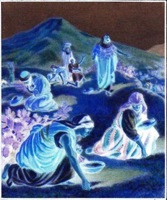Manna
Origin
Middle English, from Old English, from Late Latin, from Greek, from Hebrew mān
Definitions
- 1a : food miraculously supplied to the Israelites in their journey through the wilderness
- b : divinely supplied spiritual nourishment
- c : a usually sudden and unexpected source of gratification, pleasure, or gain
- 2a : the sweetish dried exudate of a Eurasian ash (especially Fraxinus ornus) that contains mannitol and has been used as a laxative and demulcent
- b : a similar product excreted by a scale insect (Trabutina mannipara) feeding on the tamarisk
Description
Manna (Hebrew: מָן) or Manna wa Salwa (Arabic: مَنّ, Kurdish: gezo, Persian: ترنجبين), sometimes or archaically spelled mana, is the name of a food that God provided for the Israelites during their travels in the desert as recorded in the Bible. It was said to be sweet to the taste, like honey. It is narrated in the hadith Sahih Muslim that the Muslim prophet Muhammad said "Truffles are 'manna' which Allah, sent to the people of Israel through Musa (Moses), and its juice is a medicine for the eyes."
Some scholars have proposed that manna is cognate with the Egyptian term mennu, meaning "food". At the turn of the twentieth century, Arabs of the Sinai Peninsula were selling resin from the tamarisk tree as man es-simma, roughly meaning "heavenly manna". Tamarisk trees (particularly Tamarix gallica) were once comparatively extensive throughout the southern Sinai, and their resin is similar to wax, melts in the sun, is sweet and aromatic (like honey), and has a dirty-yellow color, fitting somewhat with the Biblical descriptions of manna. However, this resin is mostly composed from sugar, so it would be unlikely to provide sufficient nutrition for a population to survive over long periods of time, and it would be very difficult for it to have been compacted to become cakes.
In the Biblical account, the name manna is said to derive from the question man hu, seemingly meaning "What is it?"; this is perhaps an Aramaic etymology, not a Hebrew one. Man is possibly cognate with the Arabic term man, meaning plant lice, with man hu thus meaning "this is plant lice", which fits one widespread modern identification of manna, the crystallized honeydew of certain scale insects. In the environment of a desert, such honeydew rapidly dries due to evaporation of its water content, becoming a sticky solid, and later turning whitish, yellowish, or brownish; honeydew of this form is considered a delicacy in the Middle East, and is a good source of carbohydrates.
The other widespread identification is that manna is the thalli of certain lichens (particularly Lecanora esculenta); this food source is often used as a substitute for maize in the Eurasian Steppe. This material is light, often drifting in the wind, and has a yellow outer coat with a white inside, somewhat matching the Biblical description of manna; it does need additional drying, but is definitely not similar to honey in taste.
A number of ethnomycologists such as R. Gordon Wasson, John Marco Allegro, and Terence McKenna, have suggested that most characteristics of manna are similar to that of Psilocybe cubensis mushrooms, notorious breeding grounds for insects, which decompose rapidly. These peculiar fungi naturally produce a number of molecules that resemble human neurochemicals, and first appear as small fibres (mycelia) that resemble hoarfrost. This speculation (also paralleled in Philip K. Dick's posthumously published The Transmigration of Timothy Archer) is supported in a wider cultural context when compared with the praise of Haoma in the Rigveda, Mexican praise of teonanácatl, the peyote sacrament of the Native American Church, and the Holy Ayahuasca used in the ritual of the União do Vegetal and Santo Daime.
Other minority identifications of manna are that it was a kosher species of locust, or that it was the sap of certain succulent plants (such as those of the genus Alhagi), which have an appetite-suppressing effect).
